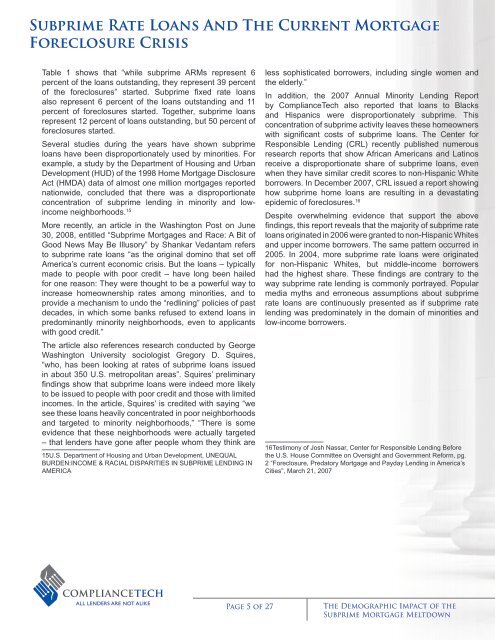Download Conference Presentations - Mortgage Lending Industry ...
Download Conference Presentations - Mortgage Lending Industry ...
Download Conference Presentations - Mortgage Lending Industry ...
You also want an ePaper? Increase the reach of your titles
YUMPU automatically turns print PDFs into web optimized ePapers that Google loves.
Subprime Rate Loans And The Current <strong>Mortgage</strong><br />
Foreclosure Crisis<br />
Table 1 shows that “while subprime ARms represent 6<br />
percent of the loans outstanding, they represent 39 percent<br />
of the foreclosures” started. Subprime fixed rate loans<br />
also represent 6 percent of the loans outstanding and 11<br />
percent of foreclosures started. Together, subprime loans<br />
represent 12 percent of loans outstanding, but 50 percent of<br />
foreclosures started.<br />
Several studies during the years have shown subprime<br />
loans have been disproportionately used by minorities. For<br />
example, a study by the department of Housing and Urban<br />
development (HUd) of the 1998 Home mortgage disclosure<br />
Act (HmdA) data of almost one million mortgages reported<br />
nationwide, concluded that there was a disproportionate<br />
concentration of subprime lending in minority and lowincome<br />
neighborhoods. 15<br />
more recently, an article in the Washington Post on June<br />
30, 2008, entitled “Subprime mortgages and Race: A Bit of<br />
Good News may Be Illusory” by Shankar Vedantam refers<br />
to subprime rate loans “as the original domino that set off<br />
America’s current economic crisis. But the loans – typically<br />
made to people with poor credit – have long been hailed<br />
for one reason: They were thought to be a powerful way to<br />
increase homeownership rates among minorities, and to<br />
provide a mechanism to undo the “redlining” policies of past<br />
decades, in which some banks refused to extend loans in<br />
predominantly minority neighborhoods, even to applicants<br />
with good credit.”<br />
The article also references research conducted by George<br />
Washington University sociologist Gregory d. Squires,<br />
“who, has been looking at rates of subprime loans issued<br />
in about 350 U.S. metropolitan areas”. Squires’ preliminary<br />
findings show that subprime loans were indeed more likely<br />
to be issued to people with poor credit and those with limited<br />
incomes. In the article, Squires’ is credited with saying “we<br />
see these loans heavily concentrated in poor neighborhoods<br />
and targeted to minority neighborhoods,” “There is some<br />
evidence that these neighborhoods were actually targeted<br />
– that lenders have gone after people whom they think are<br />
15 U.S. department of Housing and Urban development, UNEQUAL<br />
BURDEN:INCOME & RACIAL DISPARITIES IN SUBPRIME LENDING IN<br />
AmERICA<br />
less sophisticated borrowers, including single women and<br />
the elderly.”<br />
In addition, the 2007 Annual minority <strong>Lending</strong> Report<br />
by ComplianceTech also reported that loans to Blacks<br />
and Hispanics were disproportionately subprime. This<br />
concentration of subprime activity leaves these homeowners<br />
with significant costs of subprime loans. The Center for<br />
Responsible <strong>Lending</strong> (CRL) recently published numerous<br />
research reports that show African Americans and Latinos<br />
receive a disproportionate share of subprime loans, even<br />
when they have similar credit scores to non-Hispanic White<br />
borrowers. In december 2007, CRL issued a report showing<br />
how subprime home loans are resulting in a devastating<br />
epidemic of foreclosures. 16<br />
despite overwhelming evidence that support the above<br />
findings, this report reveals that the majority of subprime rate<br />
loans originated in 2006 were granted to non-Hispanic Whites<br />
and upper income borrowers. The same pattern occurred in<br />
2005. In 2004, more subprime rate loans were originated<br />
for non-Hispanic Whites, but middle-income borrowers<br />
had the highest share. These findings are contrary to the<br />
way subprime rate lending is commonly portrayed. Popular<br />
media myths and erroneous assumptions about subprime<br />
rate loans are continuously presented as if subprime rate<br />
lending was predominately in the domain of minorities and<br />
low-income borrowers.<br />
16 Testimony of Josh Nassar, Center for Responsible <strong>Lending</strong> Before<br />
the U.S. House Committee on Oversight and Government Reform, pg.<br />
2 “Foreclosure, Predatory mortgage and Payday <strong>Lending</strong> in America’s<br />
Cities”, march 21, 2007<br />
Page 5 of 27 The Demographic Impact of the<br />
Subprime <strong>Mortgage</strong> Meltdown


